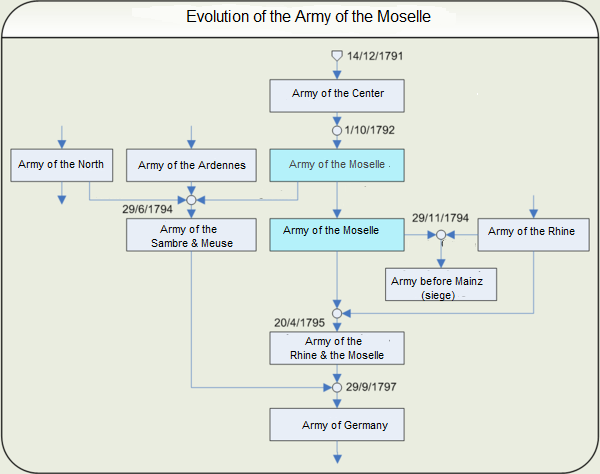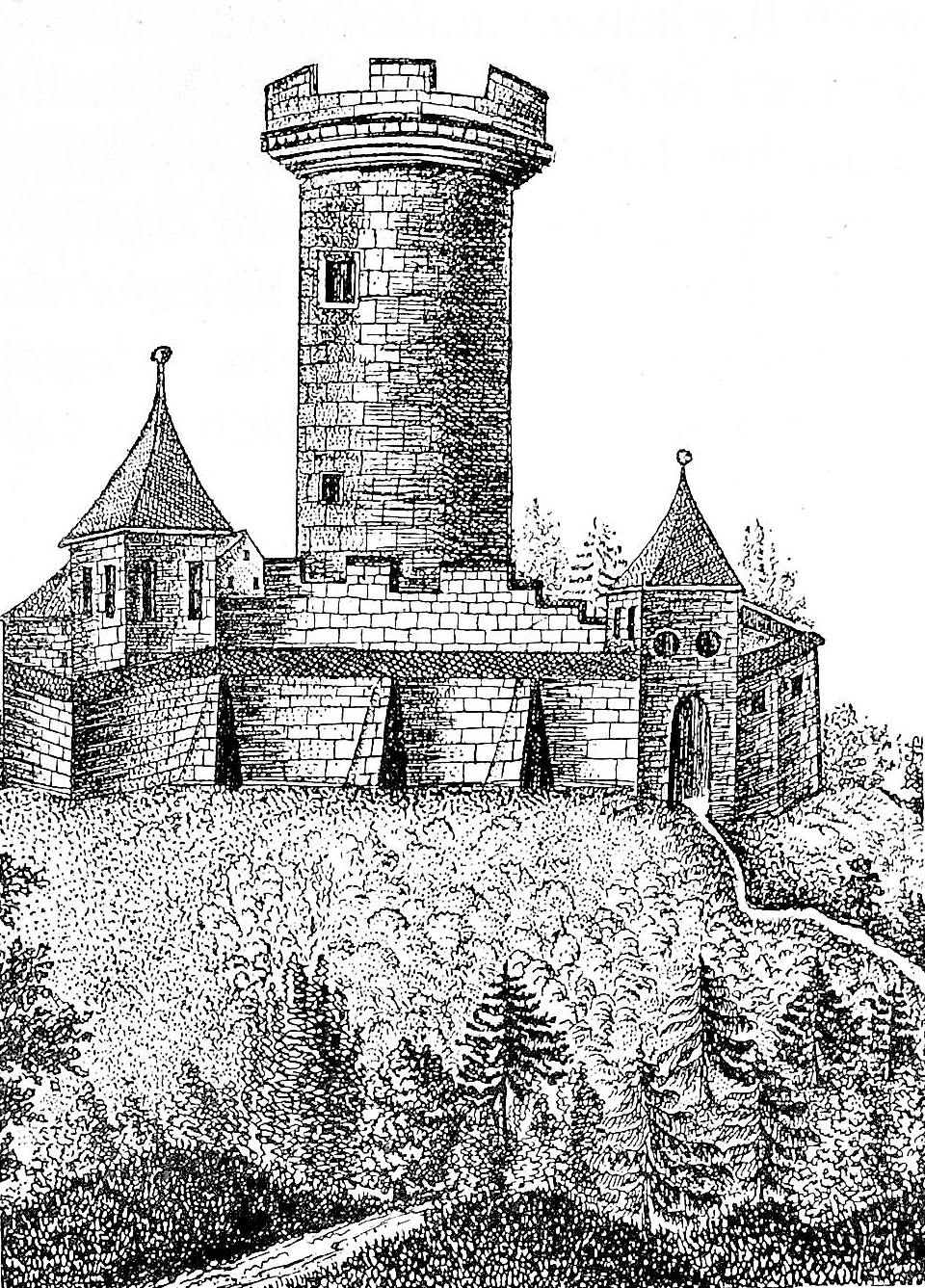|
Alexis Balthazar Henri Schauenburg
Balthazar Alexis Henri Schauenburg (also spelled Schauenbourg), (born in Hellimer on 31 July 1748 and died in Geudertheim on 1 September 1831) was a French general who served in the wars of the French Revolution and the Empire. He briefly commanded the ''Army of the Moselle'' in 1793 during the War of the First Coalition. A nobleman, he joined the French Royal Army as a sous-lieutenant in 1764. The French Revolution led to rapid promotion and then to arrest for the crime of being an aristocrat. Later restored to command, he commanded Kehl in 1796 and invaded Switzerland in 1798. He served in Jean Victor Marie Moreau's army in 1800 and held commands in the interior under the First French Empire. He retired from the army in 1814 and died in 1831. Schawembourg is one of the names inscribed under the Arc de Triomphe, on Column 23. Family The family of Schauenburg dates to the eleventh century, and the union of Utha, daughter of Godfrey count of Calw, with Luitgarde of the house of ... [...More Info...] [...Related Items...] OR: [Wikipedia] [Google] [Baidu] |
Hellimer
Hellimer is a commune in the Moselle department in Grand Est in north-eastern France. Notable people * Balthazar Alexis Henri Schauenburg, (also spelled Schauenbourg), was born in Hellimer on 31 July 1748 and died in Geudertheim on 1 September 1831) was a French general who served in the wars of the French Revolution and the Empire. See also * Communes of the Moselle department The following is a list of the 725 communes of the Moselle department of France. The communes cooperate in the following intercommunalities (as of 2020):Communes of Moselle (department) {{ForbachBoulayMoselle-geo-stub ... [...More Info...] [...Related Items...] OR: [Wikipedia] [Google] [Baidu] |
Army Of The Moselle
The Army of the Moselle (''Armée de la Moselle'') was a French Revolutionary Army from 1791 through 1795. It was first known as the ''Army of the Centre'' and it fought at Valmy. In October 1792 it was renamed and subsequently fought at Trier, First Arlon, Biesingen, Kaiserslautern, Froeschwiller and Second Wissembourg. In the spring of 1794 the left wing was detached and fought at Second Arlon, Lambusart and Fleurus before being absorbed by the ''Army of Sambre-et-Meuse''. In late 1794, the army captured Trier and initiated the Siege of Luxembourg. During the siege, the army was discontinued and its divisions were assigned to other armies. History Originally known as the ''Army of the Centre'', it was renamed by decree of the National Convention on 1 October 1792 and kept under that name in the decrees of 1 March and 30 April 1793. By the decree of 29 June 1794 its left wing joined with the ''Army of the Ardennes'' and the right wing of the ''Army of the North'' to form the ... [...More Info...] [...Related Items...] OR: [Wikipedia] [Google] [Baidu] |
Christian Of The Palatinate-Zweibrücken (1752–1817)
Christian Graf von Forbach, then Christian Marquis de Deux-Ponts and later Christian Freiherr von Zweibrücken (20 November 1752 – 25 October 1817) was an officer of the French Army and later a general of the Royal Prussian and then of the Bavarian Army, at last in the rank of General der Infanterie.''Zweibrücken'' (German), Pierer's Universal-Lexikon. He may not be confused with his nephew Christian Freiherr von Zweibrücken (aka Christian Graf von Forbach, 1782–1859), who was a Bavarian General of Cavalry (''''). ... [...More Info...] [...Related Items...] OR: [Wikipedia] [Google] [Baidu] |
Stauffenberg
The Schenk von Stauffenberg family is a noble (''Uradel'') Roman Catholic family from Swabia in Germany. The family's best-known recent member was Colonel Claus Schenk Graf von Stauffenberg – the key figure in the 1944 "20 July plot" to assassinate Adolf Hitler. History The recorded history of the Schenk von Stauffenberg family begins in Swabia in the 13th century, when the family, who belonged to the Reichsrittern (Imperial Knights), originated from the settlement Cell, where they owned extensive estates surrounding the village and the Zollerberg. Its first known member is mentioned in 1251 as Wernherus Pincerna de Celle, who in 1255 was appointed to the ceremonial court office of (cup-bearer, sommelier, butler) with the Counts of Zollern. The officeholder was in charge of his lord's wine cellars and vineyards, and when the office of Schenk later became hereditary within the family, the title was adopted into the family name. Surnames were appended according to the of ... [...More Info...] [...Related Items...] OR: [Wikipedia] [Google] [Baidu] |
Henry The Great
Henry IV (french: Henri IV; 13 December 1553 – 14 May 1610), also known by the epithets Good King Henry or Henry the Great, was King of Navarre (as Henry III) from 1572 and King of France from 1589 to 1610. He was the first monarch of France from the House of Bourbon, a cadet branch of the Capetian dynasty. He was assassinated in 1610 by François Ravaillac, a Catholic zealot, and was succeeded by his son Louis XIII. Henry was the son of Jeanne III of Navarre and Antoine de Bourbon, Duke of Vendôme. He was baptised as a Catholic but raised in the Protestant faith by his mother. He inherited the throne of Navarre in 1572 on his mother's death. As a Huguenot, Henry was involved in the French Wars of Religion, barely escaping assassination in the St. Bartholomew's Day massacre. He later led Protestant forces against the French royal army. Henry became king of France in 1589 upon the death of Henry III, his brother-in-law and distant cousin. He was the first Fr ... [...More Info...] [...Related Items...] OR: [Wikipedia] [Google] [Baidu] |
House Of Zähringen
The House of Zähringen (german: Zähringer) was a dynasty of Swabian nobility. The family's name derived from Zähringen Castle near Freiburg im Breisgau. The Zähringer in the 12th century used the title of Duke of Zähringen, in compensation for having conceded the title of Duke of Swabia to the Staufer in 1098. The Zähringer were granted the special title of Rector of Burgundy in 1127, and they continued to use both titles until the extinction of the ducal line in 1218. The territories and fiefs held by the Zähringer were known as the 'Duchy of Zähringen' (), but it was not seen as a duchy in equal standing with the old stem duchies. The Zähringer attempted to expand their territories in Swabia and Burgundy into a fully recognized duchy, but their expansion was halted in the 1130s due to their feud with the Welfs. Pursuing their territorial ambitions, the Zähringer founded numerous cities and monasteries on either side of the Black Forest, as well as in the western S ... [...More Info...] [...Related Items...] OR: [Wikipedia] [Google] [Baidu] |
Calw
Calw (; previously pronounced and sometimes spelled ''Kalb'' accordingly) is a town in the middle of Baden-Württemberg in the south of Germany, capital and largest town of the district Calw. It is located in the Northern Black Forest and is approximately south of Pforzheim and west of Stuttgart. It has the status of a ''große Kreisstadt.'' Geography Location Calw is located in the valley of the Nagold in the Northern Black Forest at an altitude between above sea level. The historic centre lies west of the river. The newer parts of town have developed on the surrounding slopes. The following streams also exist within the town: the Tälesbach, Ziegelbach, Wurstbrunnenbach, Schießbach, Schlittenbach und Schweinbach. In the northern part of the town, on the western slope of the Nagold valley is the cave known as the Bruderhöhle. Neighbouring Communities The following towns and communities ('' Gemeinden'') border on the town of Calw (clockwise, from the north): Bad Liebe ... [...More Info...] [...Related Items...] OR: [Wikipedia] [Google] [Baidu] |
Names Inscribed Under The Arc De Triomphe
The following is a list of the 660 names inscribed under the Arc de Triomphe, in Paris. Most of them represent generals who served during the French First Republic (1792–1804) and the First French Empire (1804–1815). Underlined names signify those killed in action. Additionally, the names of specific armies are listed, grouped together by the four compass facades of the arch: North (northern France, lower Rhine, Netherlands), East (Central Europe, Switzerland, Italy), South (Mediterranean Europe, Egypt, southern France) and West (Pyrenees, western France, notable units). Related list: Battles inscribed on the Arc de Triomphe. File:Paris Arc de Triomphe inscriptions 2.jpg, Northern pillar Armies of northern France, the lower Rhine and the Netherlands. File:Paris Arc de Triomphe inscriptions 3.jpg, Eastern pillar Armies of Central Europe, Switzerland and Italy. File:Paris Arc de Triomphe inscriptions 7.jpg, Southern pillar Armies of Mediterranean Europe, Egypt and souther ... [...More Info...] [...Related Items...] OR: [Wikipedia] [Google] [Baidu] |
Jean Victor Marie Moreau
Jean Victor Marie Moreau (, 14 February 1763 – 2 September 1813) was a French general who helped Napoleon Bonaparte to power, but later became a rival and was banished to the United States. Biography Rise to fame Moreau was born at Morlaix in Brittany. His father was a successful lawyer, and instead of allowing Moreau to enter the army, as he attempted to do, insisted on Moreau studying law at the University of Rennes. Young Moreau showed no inclination for law, but reveled in the freedom of student life. Instead of taking his degree, he continued to live with the students as their hero and leader, and formed them into a sort of army, which he commanded as their provost. When 1789 came, he commanded the students in the daily affrays which took place at Rennes between the young noblesse and the populace. In 1791, Moreau was elected a lieutenant colonel of the volunteers of Ille-et-Vilaine. With them he served under Charles François Dumouriez, and in 1793 the good order o ... [...More Info...] [...Related Items...] OR: [Wikipedia] [Google] [Baidu] |
Switzerland
). Swiss law does not designate a ''capital'' as such, but the federal parliament and government are installed in Bern, while other federal institutions, such as the federal courts, are in other cities (Bellinzona, Lausanne, Luzern, Neuchâtel, St. Gallen a.o.). , coordinates = , largest_city = Zürich , official_languages = , englishmotto = "One for all, all for one" , religion_year = 2020 , religion_ref = , religion = , demonym = , german: Schweizer/Schweizerin, french: Suisse/Suissesse, it, svizzero/svizzera or , rm, Svizzer/Svizra , government_type = Federalism, Federal assembly-independent Directorial system, directorial republic with elements of a direct democracy , leader_title1 = Federal Council (Switzerland), Federal Council , leader_name1 = , leader_title2 = , leader_name2 = Walter Thurnherr , legislature = Fe ... [...More Info...] [...Related Items...] OR: [Wikipedia] [Google] [Baidu] |
Kehl
Kehl (; gsw, label= Low Alemannic German, Low Alemannic, Kaal) is a town in southwestern Germany in the Ortenaukreis, Baden-Württemberg. It is on the river Rhine, directly opposite the French city of Strasbourg, with which it shares some municipal servicesfor example the Strasbourg tramway, which now reaches Kehl. History The village of Kehl was first mentioned in 1038. In 1338 the first permanent bridge between Kehl and Strasbourg was completed. In 1678 the city was taken over by France, as it was considered to be part of the defence system of Strasbourg. Hence the village was transformed into a fortress in 1683 by the French architect Vauban. In 1681, the Free imperial city, Imperial City of Strasbourg, a territory of the Holy Roman Empire that included Kehl, was annexed by Louis XIV of France, Louis XIV, King of Early modern France, France. This annexation was recognised by the Treaty of Ryswick in 1697, but all right-bank territories were restored to the Empire, leading to ... [...More Info...] [...Related Items...] OR: [Wikipedia] [Google] [Baidu] |






